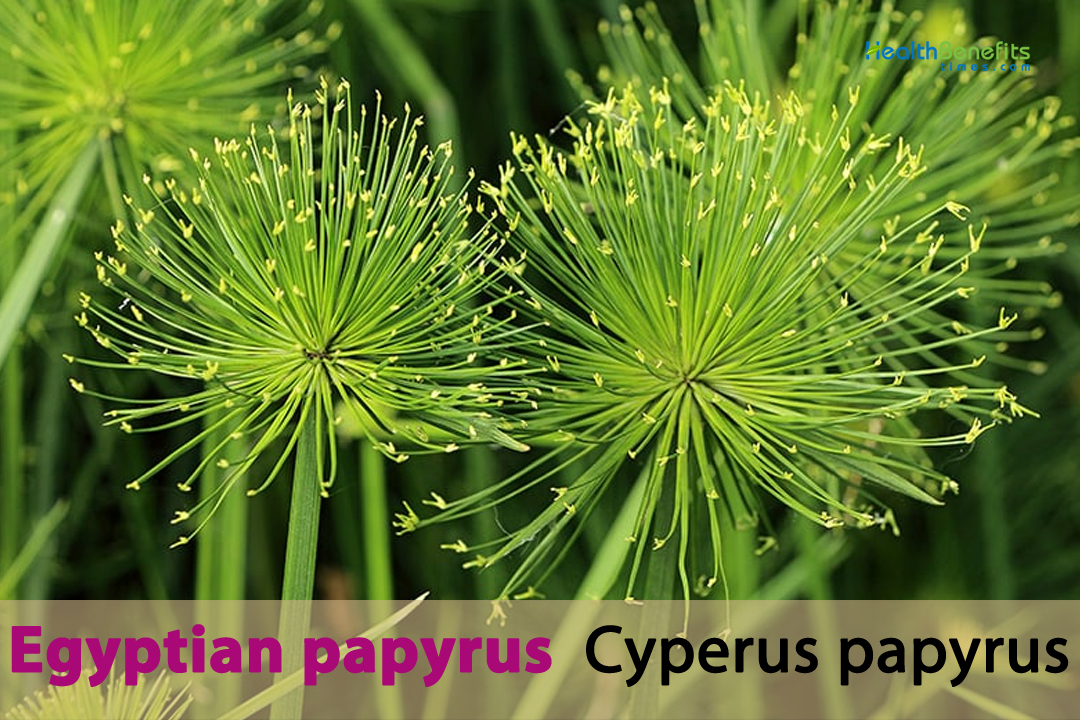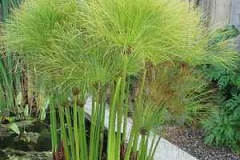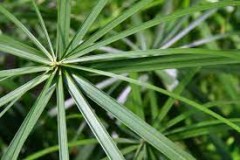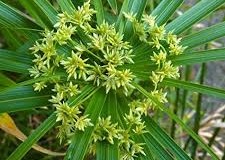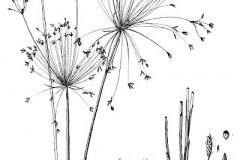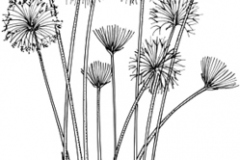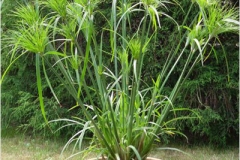The name “Cyperus” comes from the Latin word “cyperos,” which means “sedge.” Sedges are grass-like plants that grow in wet or swampy places. The papyrus plant is a member of this family. The species name “papyrus” comes from the well-known paper made from the roots of the plant. As was already said, the ancient Egyptians made a writing surface out of the stem of the papyrus plant, which they also called “papyrus.”
People have been using this plant for more than 4,000 years. The ancient Egyptians used it to make a type of paper. In tropical and warm temperate parts of the world, it is often grown as a decorative plant. Cyperus papyrus is found all over the world. Its number may be going down in some areas because farmers are draining and burning swamps to make room for crops, but this isn’t likely to happen on a large enough scale for the species to be considered threatened. The IUCN Red List of Threatened Species says that the plant is of “Least Concern.”
Egyptian Papyrus Facts
| Egyptian papyrus Quick Facts | |
|---|---|
| Name: | Egyptian papyrus |
| Scientific Name: | Cyperus papyrus |
| Origin | Central Africa and the Nile Valley |
| Colors | Initially green turning to light to dark brown color as they mature |
| Shapes | Small Nutlets typically measuring a few millimeters in length and are oblong or ovoid in shape, with a slightly flattened appearance |
| Health benefits | Wound Healing, Fever Reduction, Skin health, Pain Relief, Respiratory Health, Menstrual Disorders, Stress and Anxiety, Cardiovascular Health, Gastrointestinal Aid and Liver Support |
| Name | Egyptian papyrus |
|---|---|
| Scientific Name | Cyperus papyrus |
| Native | Africa (i.e. Ethiopia, Sudan, Kenya, Tanzania, Uganda, Cameroon, Zaire, Benin, Nigeria, Senegal, Malawi, Mozambique, Zimbabwe, Botswana, Namibia, South Africa and Madagascar) |
| Common Names | Giant papyrus, Nile papyrus, Paper plant, Egyptian sedge, Papyrus grass, Papyrus rush, Egyptian paper rush, Nile reed, Papyrus cane, Papyrus weed, Paper reed sedge, Egyptian paper reed, Nile grass sedge, Nile delta sedge, Paper bulrush, Egyptian water plant, Papyrus water sedge |
| Name in Other Languages | Afrikaans: Egiptiese papyrus Amharic: K’ēt’ema (ቄጠማ) Angika: Ījipshiyan Peparas (ईजिप्शियन पेपरस्) Arabic: Babir Masri (بابير مصري), Al-Bardi Al-Masri (البردي المصري), Bardí (بردي), saed bardi (سعد بردي) Assamese: Ijipṭiyaan pyaapiraash (ইজিপ্তিয়ান প্যাপিৰাছ) Asturian: Papiru Azerbaijani: Papirus Bengali: Mishrī pyapirāsa (মিশরী প্যাপিরাস), Mishrīẏa pyēpirāsa (মিশরীয় প্যাপিরাস) Bodo: Ijipṭiyān pepeṛāsh (ইজিপ্টিয়ান পেপেৰাছ) Catalan: Papiro egipci Chhattisgarhi: Ijipśiyana pēparsa (ईजिप्शियन पैपरस्) Chinese: Āijí zhǐ shācǎozhǐ (埃及纸莎草纸) , Zhǐ suō cǎo (纸莎草) Croatian: Papirus Czech: Egyptský papyrus, šáchor papírodárný Danish: Egyptisk papyrus, Papyrusfladaks Dogri: Ījipshiyan paiparās (ईजिप्शियन पैपरास) Dutch: Egyptische papyrus, Papirus, Papyrusriet Egypt: Tjufy English: Egyptian Papyrus, Bulrushes, Egyptian paper plant, Egyptian paper reed, Egyptian papyrus, Mediterranean sedge, Paper reed, Papyrus, paper plant, Papyrus Sedge, Papyrus Flat Sedge, Indian matting plant, Nile grass Esperanto: Papiruscipero Estonian: Egiptuse papüürus, Papüürus-lõikhein Finnish: Egyptiläinen papyrus, Papyruskaisla French: Papyrus égyptien, Jonc du nil, Papyrus, Plante à papier du Nil, Papyrus du Nil, Souchet à papier, Souchet du Nil, Papier du Nil Galician: Papiro Garo: Ijipṭiyān Pepeṛāch (ইজিপ্তিয়ান পেপেৰাছ) Georgian: Egviturī pap’irusi (ეგვიპტური პაპირუსი), p’ap’iri (პაპირი) German: Ägyptische Papyrusrolle, Ägyptische Papyrus, Papyrusstaude, Papyrus-Zypergras, Papyrus, Echter Papyrus Greek: Aigyptiakó papyrus (Αιγυπτιακό πάπυρος), kýpeiros pápyros (κύπειρος πάπυρος) Hebrew: Papyrus Mitri (פפירוס מצרי), גומא פפירוס Hindi: Misrī papīras (मिस्री पपीरस) Hungarian: Egyiptomi papirusz, papirusz, papiruszsás Icelandic: Egyptnesk pappírús Indonesian: Papirus Mesir Israel: Gomeh Italian: Papiro egiziano, Papiro, giunco del Nilo Japanese: Ejiputo no papi rusu (エジプトのパピルス), Papirusu (パピルス), kamigayatsuri (カミガヤツリ) Kabyle: Udid (imɣi) Kashmiri: Ējīpshīn pēpīrās (ایجیپشین پیپیراس) Kazakh: Papirus (Папирус) Kenya: Mafunjo, njaanjaa Khasi: Ijipṭiyan Pāpiras (इजिप्तियन पापिरस्) Kinyarwanda: Urufunzo Kokborok: Ijipṭiyān Pāpiras (ইজিপ্টিয়ান পাপিরাস) Konkani: Ijipshiyan pêpāyars (इजिप्शियन पॅपायरस) Korean: Ijibteu papiryuseu (이집트 파피루스), Pa pi ru su (파피루스) Kyrgyz: Papirus (Папирус) Latvian: Ēģiptes papīrs Lithuanian: Egipto papirusas, Papirusinė viksvuolė Livvi: Papirus Macedonian: Egipetski papyrus (Египетски папирус) Madagascar: Hisatra Maithili: Ijipiṭiyan papairas (इजिप्तियन पपईरस) Malagasy: Zozoro papirosy Malayalam: Ejipṣyan pāppiṟan (എജിപ്ഷ്യൻ പാപ്പിറൻ), nailgraas (നൈൽഗ്രാസ്) Manipuri: Ijipṭiyaan pyaapiras (ইজিপ্তিয়ান প্যাপিরাস্) Mingrelian: Ch’oli (p’ap’irusi) (ჭოლი (პაპირუსი)) Nepali: Ijipiṭiyan papāyras (इजिप्टियन पपायरस), Guda mothe, Kagat mothe Norwegian: Egyptisk papyrus Odia: Ijipiṭiāna pyāpiras (ଇଜିପ୍ଟିଆନ ପ୍ୟାପିରସ୍) Ossetian: Папирус Persian: نی مردابی Polish: Papirus egipski, cibora papirusowa Portuguese: Papiro egípcio, Papiro, papiro-do-Egipto, Papiro Quechua: Papyru Íxiptu Chhattisgarhi: Ijipśiyana pēparsa (ईजिप्शियन पैपरस्) Rajsthani: Ijiptiyan pepars (ईजिप्टियन पेपरस्) Romanian: Papirus egiptean Russian: Yegipetskiy papyrus (Египетский папирус), Egipetskiy papyrus (Египетский папирус), papirus (папирус), syt’ papirusnaya (сыть папирусная) Sanskrit: Misriya Patrika (मिस्रिय पत्रिका) Santali: Ijipṭiyān pepeṛach (ইজিপ্তিয়ান পেপেরছ) Serbian: Egiptanski papyrus (Египатски папирус), Papirus (Папирус) Shona: Nhokwe Sindhi: Ijipṭiyāī pīp̱ars (اڄيپٽيائي پيپرس) South Africa: Papirus Spanish: Papiro egipcio, Papiro, Papiro del Nilo Swahili: Papyrus ya Misri Swedish: Egyptisk papyrus, Papperssäv, Papyrus Tagalog: Papyrus ng Ehipto Tamil: Ekipthiya tarappu (எகிப்திய தரப்பு), Paṉpul (பன்புல்) Tanzania: Lifwama, matere Thai: Kradaat Pha Phoerus (กระดาษไพเพอรัส), Pha-phoe-rat khong Iyip dì (ไพเพอรัสของอียิปต์), Kok i yip (กกอียิปต์) Telugu: Ījipṣiyan pāpiras (ఈజిప్షియన్ పాపైరస్) Tulu: Ījipshiyan Pēparas (ಈಜಿಪ್ಶಿಯನ್ ಪೇಪರಸ್) Turkish: Mısır papirüsü Ukrainian: Yehyptytsʹkyy papyrus (Єгипетський папірус) Upper Sorbian: Papjerowc Urdu: Misrii Kaghaz (مصری کاغذ) USA/Hawaii: kaluha, papulo Uzbek: Papirus Vietnamese: Giấy mờ Ai Cập, Giấy tre Ai Cập, Bản sao Ai Cập, Cói giấy Welsh: Papyrus Yr Aifft Xhosa: I-Papyrus yaseGibhithe Yiddish: Egyiptishe papyrus (עגיפטישע פּאַפּירוס) Zulu: I-Papyrus yaseGibhithe |
| Plant Growth Habit | Fast-growing, tall, semi-aquatic, grass-like, clump-forming, perennial rhizomatous sedge |
| Growing Climates | Marshy areas, along the banks of rivers, other wetland habitats, water features, ponds, garden landscapes, swamps, shallow lakes and along stream banks |
| Soil | Prefers rich, fertile soil with good organic content. It can grow in various soil types, including clay, loam, and sandy soils, as long as they retain moisture well |
| Plant Size | Around 10 to 15 feet (3 to 4.5 meters) or even taller and around 3 to 4 feet (0.9 to 1.2 meters) wide |
| Root | Tough and able to extend 1 m or more. Rootlets are numerous |
| Stem | Cylindrical and jointed. At regular intervals along the stem’s length, nodes are formed. These nodes give the stem its segmented appearance, and they play a crucial role in the plant’s growth and development |
| Bark | Bark is composed of a fibrous tissue. This fibrous layer is tough, flexible, and helps protect the inner tissues of the stem |
| Leaf | Long, slender, and ribbon-like, with a distinct linear shape. They can grow quite tall, ranging from 2 to 5 meters in height and reddish-blackish brown in color when young |
| Flower | Flowers are relatively small in size, typically measuring a few millimeters in diameter. They are not showy like many other flowering plants but are essential for the plant’s reproduction |
| Fruit Shape & Size | Small Nutlets typically measuring a few millimeters in length and are oblong or ovoid in shape, with a slightly flattened appearance |
| Fruit Color | Initially green turning to light to dark brown color as they mature |
| Seed | Seeds are small, dark brown to black in color, and have an oval shape |
| Flavor/Aroma | Mild, slightly sweet, and reminiscent of fresh greenery |
| Plant Parts Used | Rhizomes, Roots, Leaves, Stem Fibers, resin, Flower Heads |
| Propagation | By seeds, division, Rhizome Cuttings, Water Propagation, Tissue Culture |
| Lifespan | Often between 3 to 5 years or even longer |
| Varieties |
|
| Season | June to August |
| Health benefits |
|
Plant Description
Egyptian papyrus is a tall, semi-aquatic, grass-like, clump-forming, permanent, rhizomatous plant with a root system that spreads out. It grows quickly and looks like grass. The plant is between 3 and 4.5 meters (3 to 10 feet) tall and between 0.9 and 1.2 meters (0.9 to 3 feet) wide. The plant looks like a grassy clump of green, triangle stems that grow from thick, woody roots. When the plant is young, the top of each stem has a thick cluster of thin, bright green thread-like rays about 10 to 30 cm long. This makes the plant look like a feather duster. The plant grows in wetlands, along the sides of rivers, in swamps, shallow lakes, and in gardens. The plant likes to grow in dirt that is rich and full of organic matter. It can grow in different types of dirt, like clay, loam, and sand, as long as they keep water well.
Appropriate growing environment of Egyptian papyrus
Egyptian papyrus is a water-loving plant that thrives in a specific growing environment. Here are the key factors that contribute to the appropriate growing conditions for Egyptian papyrus:
- Water: Papyrus is a half-water plant that needs a lot of water to grow well. It grows best in shallow water, marshy places, or along the banks of rivers and ponds. The water should be still or move very slowly, because strong currents can pull the plant out of the water.
- Sunlight: Papyrus grows best when it gets lots of sun. To grow well, it needs at least 6 to 8 hours of direct sunshine every day.
- Soil: The plant likes to grow in dirt that is rich and full of organic matter. It can grow in different types of dirt, like clay, loam, and sand, as long as they keep water well.
- Temperature: Papyrus grows best in places that are warm and tropical. It can live in temperatures between 20°C and 30°C (68°F and 86°F), but it may have trouble in colder weather.
- Humidity: Papyrus likes high amounts of humidity. Its natural home in Egypt is close to water, which makes it a wet place to live.
- Planting Depth: When growing papyrus, it’s important to keep the roots under water or in wet soil. The best depth for putting is about 2 to 4 inches (about 5 to 10 cm) below the surface of the water.
- Spacing: If you want to grow more than one papyrus plant, make sure to leave enough room between them so that each plant can get enough water and light without being too crowded.
- Fertilization: Fertilizing papyrus regularly can help it grow in a healthy way. You can give plants the nutrients they need by using a balanced liquid fertilizer or organic matter.
- Pot Cultivation: If you want to grow papyrus in a container, use a big pot with holes in the bottom to keep the soil from getting too wet. Place the pot in a sunny spot and make sure the dirt is always moist.
- Maintenance: Papyrus needs regular care, like taking off dead or yellowing leaves and getting rid of bugs if needed.
- Winter Protection: In places where it gets cold, papyrus might not last through the winter outside. When this happens, you might want to bring the plant inside or protect it from freezing weather.
Root
Rhizomes make up most of the root structure. Rhizomes are underground stems that grow in a horizontal direction below the top of the soil. These underground stems, called rhizomes, are the plant’s main way of holding itself down in the often wet or swampy soil. The plant sends out new roots from the rhizomes. The nodes along the rhizome are where these roots grow. They help the plant get water and nutrients from the soil around it. They also help the plant stay in place and stop flooding, since papyrus plants tend to grow in places where water flows.
There are many root hairs that look like feathers on the adventitious roots. These root hairs greatly increase the surface area of the roots, making it easier for the roots to take in water and nutrients from their surroundings. The papyrus plant needs a lot of water to live because it usually grows in places that are always wet.
Stem
The stem is round and has joints. Nodes form every so often along the length of the stem. These nodes give the stem its divided look and are very important to the growth and development of the plant. From each node comes a whorl of long, thin leaves that form the crown of leaves at the top of the stem. There are many separate stalks that make up the stem. The individual leaves that grow from the nodes have grown together to make these stems. The stalks are empty and have a hard but flexible structure, so they can be used for a lot of different things.
The pith is a light, sponge-like tissue that makes up the inside of the stem. This woody heart goes all the way through the stem. It helps the plant stay afloat in water by making it lighter overall. This is important for the plant’s survival in its natural environment, where it grows along riverbanks and in swamps, where there is a lot of water. Most stems are green, especially when the plant is young. As the plant gets older, the stem may get a little bit of a rusty or reddish color, especially near the base.
Ancient Egyptians thought the stem was very important because of how it was made. They used it to make boats, mats, baskets, shoes, and even furniture. They also used it to make papyrus sheets, which were used for writing. In ancient times, it was used to make small boats and rafts because it was light and floated. This helped people get around and trade.
Bark
The tissue that makes up bark is brittle. This tough, flexible layer of fibers helps protect the inner parts of the stem. The woody “bark” of the plant is very important to history because it was used to make the first paper that we know of. Ancient Egyptians found that they could take off the top layer of fibers, cut the inner pith into thin strips, and then lay these strips in two layers at right angles to each other. After being pressed and dried, these layers turned into papyrus, which is a strong but flexible sheet used for writing. This invention changed the way people talked and kept track of things in the past. The bark is rough and feels a bit like paper, but it is more fibrous and doesn’t have the stiff, deeply creased look that is usually associated with tree bark.
Leaves
The leaves are long, thin, ribbon-like, and have a clear linear form. They can grow between 2 and 5 meters tall, which is one of the things that make this plant, stand out. At the top of the tall, straight stems, groups of leaves grow together to make a covering that looks like an umbrella. The arrangement is spiraled around the stem, which makes it look unique and pretty. The veins in the leaves run straight to the length of the leaf, and there are a lot of them. This pattern of veins strengthens the leaf’s structure and lets it move water and nutrients more effectively.
Healthy papyrus plants have bright green leaves, which is a sign that the plant is doing well. But the color of the leaves can change depending on how they grow and how old they are. The surface of the leaves is smooth and slightly slippery, which helps keep water from escaping too quickly and protects the leaves from damage caused by pests or diseases that travel in water. It is a plant that comes back year after year, and its leaves last a long time. Some of them last for several years before dying out and falling off on their own. The plant can only live on if it has leaves.
Flowers
Flowers grow in groups called umbels that look like umbrellas. Each umbel is made up of several individual flowers that are connected to a central point on the stalk. This gives the umbel a round and compact look. The individual flowers are usually only a few millimeters across. They aren’t as pretty as many other flowers, but they are important for the plant to grow more of its kind.
Each flower is made up of many different parts: The top whorl of a flower is called the perianth. In Egyptian papyrus, the perianth is made up of six bracts or tepals. These are called tepals. They look like petals and are generally green and papery. There are often six stamens inside the perianth. The stamens are the male parts of a flower, and they make pollen, which is needed to make a plant grow. There is one pistil in the middle of the flower. The female reproductive part is the pistil, which is made up of the stigma, style, and ovary. The stigma is where pollen sticks, and the style is the tube-like part that ties the stigma to the ovary. The ovary has ovules, which become seeds when they are fertilized. Egyptian papyrus is a plant that gets its pollen from the stamens of one flower to the stigmas of another flower thanks to the wind. This is shown by the fact that the flowers don’t have any showy petals, since they don’t need to draw pollinators like insects or birds.
Fruits
Nutlets are the small, dry, hard structures that make up fruits. The fertilized ovules in the ovary of the flower turn into these nutlets, which are an important part of the plant’s reproductive cycle. Nutlets are usually only a few millimeters long and aren’t very big. They look a little bit flattened and are either long or round. The nutlets are hard and dry on the outside, which protects the growing seed inside. Most of the time, the nutlets are light to dark brown when they are ready. This helps the nutlets hide by making them look like they belong in their surroundings.
Seeds
The seeds are small, oval, and dark brown to black in color. They aren’t too heavy, so the wind or water can easily spread them around. Most plants start making seeds when they are mature, which can take anywhere from a few months to a few years, based on how they are grown. The seeds were very important to the people of ancient Egypt. The plant itself had a huge impact on culture, economy, and religion. The seeds made it possible to grow and harvest papyrus for a long time, which was important for keeping information in writing.
Varieties of Egyptian papyrus
Egyptian papyrus refers to the paper-like material made from the pith of the papyrus plant. There are several varieties or types of papyrus used historically and in modern times. Here are some of them:
- Ancient Egyptian Papyrus: This is the kind of papyrus that old Egyptians have used for thousands of years. It was used for writing, making art, and as a flexible material that could be used in many ways.
- Coptic Papyrus: Coptic papyrus is the papyrus that was used in Egypt during the Coptic time, which lasted from about the 2nd century to the 14th century. It was still used after Christianity was brought to the area.
- Greek Papyrus: The writing on Greek papyrus is in Greek, and it comes from Egypt during the Hellenistic and Roman times. Greek papyrus has kept many important historical records and artistic works alive.
- Demotic Papyrus: The writing on Demotic papyrus is in the Demotic script, which was an ancient form of Egyptian writing used for administrative and legal reasons.
- Hieratic Papyrus: The hieratic script is used to write on hieratic papyrus. This is a cursive writing system that was used in ancient Egypt for religious texts, literature, and official papers.
- Medieval Papyrus: During the middle Ages, papyrus was still used in Egypt, especially for legal and religious papers.
Health benefits of Egyptian papyrus
Egyptian papyrus is a tall aquatic plant native to the Nile River region in Egypt. While it has a rich historical significance as the material used for writing surfaces in ancient Egypt, there is limited scientific evidence regarding its direct health benefits for human consumption. It’s important to note that more recent research might have surfaced since my last update.
1. Anti-inflammatory Properties
Egyptian papyrus has been used in traditional medicine for a long time, and this suggests that it may have anti-inflammatory qualities. Extracts from the plant have been used to help people with inflammation feel better.
2. Digestive Health
In ancient medicine, infusions or teas made from the papyrus plant were used to help digestion and ease stomach pain.
3. Diuretic Effects
In the past, papyrus extracts were used as diuretics to make people urinate more and possibly help with conditions like edema or water buildup.
4. Antioxidant Activity
Studies in the lab have shown that some compounds found in Egyptian papyrus have antioxidant qualities. Antioxidants help the body get rid of toxic free radicals and may have other health benefits as well.
5. Wound Healing
In some ancient practices, papyrus poultices were used to help wounds heal faster and keep them from getting sick.
6. Fever Reduction
In some ancient medical practices, Egyptian papyrus has been used to treat fever and its symptoms.
7. Skin conditions
In some cultures, burns and wounds, like cuts and scrapes, are treated with papyrus, which is thought to have healing qualities.
8. Pain Relief
In some countries, papyrus has been used to treat pain, especially headaches, joint pain, and muscle aches. But it’s important to remember that depending only on traditional remedies might not be as safe or effective as taking a drug that has been proven to work.
9. Respiratory Health
Papyrus has been used in some ancient ways to treat breathing problems like coughs and bronchial problems. This could be because it might be able to reduce inflammation.
10. Menstrual Disorders
Some tribes have used papyrus to ease the pain of menstruation and keep the cycle regular. But it’s important to see a doctor if you’re having problems with your period, because they could be signs of bigger health problems.
11. Stress and Anxiety
Papyrus was used in the past to help people feel less stressed and anxious, possibly because it has calming benefits. But dealing with stress and worry needs a whole-person approach, and people with mental health problems should seek professional help.
12. Immune System Support
People say that papyrus may help the immune system, but there isn’t much scientific evidence to back this up. A healthy immune system is more likely to be supported by a varied diet, regular exercise, and other practices that have been shown to work.
13. Cardiovascular Health
Some ancient uses of papyrus have to do with the fact that it might be good for your heart. These claims might be related to the fact that it is said to be a stimulant and an anti-inflammatory, which could indirectly affect heart health. But without solid proof, we don’t know for sure how it affects the cardiovascular system.
14. Antibacterial Properties
Some old practices say that extracts or preparations made from Egyptian papyrus may have antibacterial qualities that could help fight bacterial infections. But these claims need to be looked into more through careful scientific studies.
15. Anti-parasitic Potential
In some countries, parasitic infections, especially intestinal worms, were treated with papyrus. But there isn’t any strong science evidence to back up this claim right now.
16. Anti-diabetic Effects
There are unconfirmed reports that papyrus might be able to lower blood sugar, which could be helpful for people with diabetes. But these claims haven’t been proven, so they shouldn’t be used instead of proven medical methods for managing diabetes.
17. Gastrointestinal Aid
In some countries, papyrus was used to treat digestive problems like indigestion and bloating. But these claims need to be backed up by scientific study.
18. Antiviral Properties
There are claims that papyrus may have antiviral qualities, but these claims need more research to find out if they are true and what they could be used for.
19. Antifungal Activity
Some ancient ways to use papyrus involve treating infections caused by fungi. But without solid proof, it’s not clear if it will work against certain types of fungi.
20. Anti-cancer Potential
Some people who believe in traditional medicine have said that papyrus might be able to fight cancer. Still, these claims are not backed by science, and cancer care should always be based on medical interventions that have been shown to work.
21. Liver Support
In some countries, papyrus was used as a liver tonic to help the liver work better and help the body get rid of toxins. But there is no proof that these uses are safe or work well.
Traditional uses and benefits of Egyptian Papyrus
- Pulverized charcoal was used to treat some eye diseases, and ash was thought to stop malignant sores in the mouth or elsewhere from spreading.
- It was also said that if the leaves were soaked in vinegar and then burned, the ash would heal cuts.
- The pith was suggested for making the fistula bigger and drying it out.
- It was thought that ash could stop cancerous ulcers from growing in the mouth or anywhere else.
Different uses of Egyptian papyrus
Egyptian papyrus has been historically and culturally significant, and it has served various purposes throughout history. Here are different uses of Egyptian papyrus:
- Writing Material: One of the best-known things that Egyptian papyrus was used for was writing. Ancient Egyptians made sheets by putting strips of papyrus leaves on top of each other and pounding them flat. They used brushes and ink to write important texts, papers, and works of art on these sheets.
- Art and Illustrations: Papyrus was also used as a canvas for art and drawings in ancient Egypt. Papyrus was used by artists to make paintings and drawings that showed different parts of Egyptian life, mythology, and religious activities.
- Boats: Small boats and rafts were made from the strong and floaty stems of the papyrus plant. On the Nile River and other waterways, these boats were used to fish, move goods, and journey.
- Matting and Baskets: Because papyrus stalks were flexible, they could be used to make mats and baskets. These useful things were used to store things, carry things, and do other everyday things.
- Roofing and Thatching: In ancient Egypt, papyrus reeds were used to make roofs and thatch for huts and other simple buildings.
- Rope and Cordage: The long fibers of the papyrus plant were used to make bands and other types of cordage.
- Fans and Umbrellas: To protect people from the hot Egyptian sun, papyrus leaves were made into fans and shields.
- Symbolic and Religious Use: In ancient Egypt, papyrus had both holy and symbolic meanings. It was connected to the god Thoth, who was the god of writing and wisdom, and was often used in religious events and rituals.
- Burial Customs: In ancient Egypt, papyrus was sometimes used in the way people were buried. Fragments of papyrus with writing or spells on them were buried with the dead to help them in the future.
- Wetland Filtration: In some parts of the world today, papyrus marshes are used to filter water because the plant can soak up nutrients and pollutants, making the water cleaner.
- Ornamental Plant: Papyrus is grown as an ornamental plant in modern parks and landscaping. It gives ponds and other water features a tropical and classy look.
- Art and Illustrations: Papyrus was often used as a surface for making beautiful paintings, drawings, and other works of art. Ancient Egyptians used it to paint pictures of everyday life, holy ceremonies, and stories from mythology.
- Maps and Charts: Papyrus was used to make maps and charts, which were very important in ancient Egypt for navigation, land studies, and running the government.
- Letters and Correspondence: Papyrus was the most common way for people and government leaders to write and send letters to each other.
- Records and Archives: Papyrus was used to keep track of transactions, taxes, and historical events by writing important records, legal papers, and administrative archives on it.
- Education and Learning: Papyrus was used in schools and other learning places to teach young people how to write, read, and do math. On papyrus paper, students would work on their lessons.
- Book Covers and Bookmarks: Scrolls and books often had papyrus sheets on the outside to protect the valuable information inside. Smaller pieces of paper were also used as page markers.
- Ritual and Religious Use: Papyrus was used in religious events and rituals in a big way. It was used to make amulets and charms and to write hymns, prayers, and holy texts.
- Food and Medicinal Packaging: Papyrus was used by the ancient Egyptians to make containers for saving food and medicines.
- Boat-making: Even though it wasn’t as popular as other uses, papyrus was sometimes used to make small boats and rafts by weaving it into mats.
- Fans and Mats: People sewed papyrus fibers together to make fans, mats, and other things for the home.
Side effects of Egyptian papyrus
Egyptian papyrus does not have side effects in the conventional sense like medications or chemicals. However, there are some considerations related to its use and preservation that one should be aware of:
- Fragility: Papyrus is a fragile material that is easy to break if it is not treated carefully. It can get damaged by being bent, folded, or exposed to water too much.
- Mold and Mildew: Mold and mildew can grow on papyrus, especially in wet places or when it is stored in damp places. This can cause the papyrus to change color and break down.
- Insects: Insects like silverfish, booklice, and bugs are attracted to the organic material in papyrus and may eat it. This can cause damage over time.
- Fading: Writing and pictures on papyrus can fade over time, especially if they are left in the sun for a long time or are stored in the wrong way.
- Environmental Sensitivity: Papyrus doesn’t like when the temperature and humidity change. Extreme changes can cause the structure to bend, curl, or be damaged in other ways.
- Conservation Challenges: Ancient papyrus pieces and artifacts need to be kept and fixed up using special methods and controlled environments to keep them from getting worse.
- Fragments and Loss: Many old papyrus artifacts are found in pieces, which makes it hard to piece together the full text or picture correctly.
- Disintegration: Papyrus can break down over time because it is made of living things. This process can be sped up by exposure to air, light, and handling, which can cause information in old texts or drawings to be lost.
- Acidic Inks: Some of the paints that were used on papyrus in the past may have been acidic, which can cause the fibers to break down over time.
- Irreversible Damage: Papyrus damage, like tears, creases, or ink bleed-through, can’t be fixed. This makes it hard to fix or save damaged parts.
- Storage Challenges: To keep papyrus from breaking down, it is important to store it in the right way. But because they are so big and fragile, it can be hard to find a good place to store an old papyrus scroll.
- Limited Exposure: Ancient papyrus items are often only shown in museums for short periods of time because they are fragile and could be damaged by light and air.
- Sensitivity to Air Pollution: Papyrus can be affected by pollution in the air, especially certain gases, which could speed up its breakdown in dirty places.
- Loss of Historical Information: As papyrus breaks down or becomes unreadable over time, important historical information that was written on it can be lost for good.
- Susceptibility to Water Damage: Papyrus can quickly soak up water, and letting it get wet can do a lot of damage, like bending, growing mound, and making ink bleed.
- Challenges in Handling: Ancient papyrus is fragile, so you need to be careful and know what you’re doing when you handle it.
References:
http://www.theplantlist.org/tpl1.1/record/kew-237889
https://www.itis.gov/servlet/SingleRpt/SingleRpt?search_topic=TSN&search_value=39950#null
https://pfaf.org/User/Plant.aspx?LatinName=Cyperus+papyrus
https://www.missouribotanicalgarden.org/PlantFinder/PlantFinderDetails.aspx?taxonid=279798
https://www.cabidigitallibrary.org/doi/10.1079/cabicompendium.17503
https://keyserver.lucidcentral.org/weeds/data/media/Html/cyperus_papyrus.htm
https://www.flowersofindia.net/catalog/slides/Papyrus.html
https://gd.eppo.int/taxon/CYPPA
https://en.wikipedia.org/wiki/Cyperus_papyrus
https://tropical.theferns.info/viewtropical.php?id=Cyperus+papyrus
https://www.nparks.gov.sg/florafaunaweb/flora/1/9/1922
https://hort.purdue.edu/newcrop/duke_energy/Cyperus_papyrus.html
https://plants.usda.gov/home/plantProfile?symbol=CYPA8


